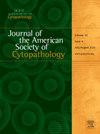国际浆液细胞病理学报告系统调查数据显示,病理学家和妇科肿瘤学家在盆腔洗涤和腹膜液标本的报告和使用方面存在很大差异。
Q2 Medicine
Journal of the American Society of Cytopathology
Pub Date : 2025-09-01
DOI:10.1016/j.jasc.2025.04.002
引用次数: 0
摘要
盆腔和腹膜冲洗(PW)通常在妇科切除术时,当肿瘤进程的存在是已知或怀疑。阳性的PW可能会抢病人的风头和/或影响病人的预后和治疗。创建了两项调查,以告知国际浆液细胞学系统,这是一个标准化的报告系统,关于PW细胞学的实践和利用。材料和方法:病理学家和细胞技术专家(n = 475)参与了一项调查,调查了他们的报告偏好。妇科肿瘤学家(GONC) (n = 168)回答了一项关于他们如何利用PW标本的单独调查。结果:大多数病理学家/细胞技术专家认为,来源不明、外观平淡的上皮细胞应归为良性。无相关上皮细胞的沙粒性钙化最倾向于报告为良性(64.1%),而8.6%的人根本没有报告这一发现,20.5%的人报告为不典型,6.8%的人报告为可疑肿瘤。大多数GONCs(63.9%)在子宫内膜癌分期期间常规获得PW标本;其中,53%的人报告细胞学阳性结果可能会改变他们的治疗方法。66%的GONCs表示,他们将不确定的PW结果视为阴性。其他人指出,不确定的PW可能导致与病理学家一起检查载玻片,咨询患者,和/或更密切的观察。大多数GONCs在沙质钙化、粘蛋白存在、偏向良性的非典型细胞、子宫内膜细胞或医源性物质的报告中没有发现用处。结论:病理学家在如何报告PW标本以及妇科肿瘤学家如何利用这些标本方面存在着实质性的差异。本文章由计算机程序翻译,如有差异,请以英文原文为准。
The International System for Reporting Serous Fluid Cytopathology survey data reveal substantial variability in the reporting and utilization of pelvic washing and peritoneal fluid specimens among pathologists and gynecologic oncologists
Introduction
Pelvic and peritoneal washings (PW) are often taken during gynecologic resections when the presence of a neoplastic process is known or suspected. A positive PW may upstage a patient and/or impact a patient's prognosis and treatment. Two surveys were created to inform The International System for Serous Fluid Cytology, a standardized reporting system, regarding the practice and utilization of PW cytology.
Materials and methods
Pathologists and cytotechnologists (n = 475) responded to a survey which examined their reporting preferences. Gynecologic oncologists (GONC) (n = 168) answered a separate survey which examined how they utilized PW specimens.
Results
Most pathologists/cytotechnologists felt that bland-appearing epithelial cells of unknown origin should be classified as benign. Most favored reporting psammomatous calcification without associated epithelial cells as benign (64.1%), whereas 8.6% did not report this finding at all, 20.5% would report as atypical, and 6.8% would report as suspicious of a neoplasm. Most GONCs (63.9%) routinely obtained PW specimens during endometrial cancer staging; of those, 53% reported that a positive cytology result could change their management. Sixty-six percent of GONCs indicated that they treat indeterminate PW results as negative. Others indicated that an indeterminate PW may result in review of slides with the pathologist, counseling the patient, and/or closer observation. Most GONCs did not find utility in the reporting of psammomatous calcifications, presence of mucin, atypical cells favored to be benign, endometrial cells, or iatrogenic material.
Conclusions
Substantial variability exists among pathologists in how PW specimens are reported, as well as how gynecologic oncologists utilize these specimens.
求助全文
通过发布文献求助,成功后即可免费获取论文全文。
去求助
来源期刊

Journal of the American Society of Cytopathology
Medicine-Pathology and Forensic Medicine
CiteScore
4.30
自引率
0.00%
发文量
226
审稿时长
40 days
 求助内容:
求助内容: 应助结果提醒方式:
应助结果提醒方式:


